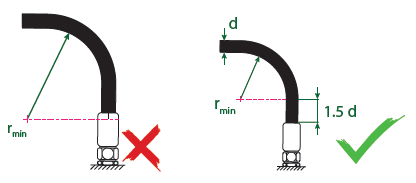1. Length
The hose must have as optimal length as possible. It its important to have a length that accommodates movement, expansion, and contraction. The length of the hose can change under pressure/pressure shock, and this must be considered. Never use a hose that is too short, excessive length is also not recommended.


2. Bending:
The structure of a hydraulic hose means it has a minimum bending radius (MBR). MBR means that the hose cannot be bent more without being damaged and must be taken out of service. The MBR for any hose is available in the hose datasheet. When installing a hose, it may be necessary to use special couplings to prevent the hose from exceeding the MBR.

It is also essential to ensure that the hose is not bent too close to the fitting.
Optimally, the hose should be straight for a length of 1.5 x hose diameter at the rear edge of the sleeve before bending is applied.

3. Torsional twisting:
Avoid torsional twisting of the hose. The internal stresses caused by torsion can cause the reinforcement to separate and puncture the hose where the load is maximum or close to the fittings. Just 7% torsion can reduce the service life by up to 90%.


4. Obstacles:
Avoid contact with objects that may cause wear or damage. On moving applications, it is important to adopt the correct hose length to avoid stretching and wear. Properly adapted hose lengths are easier to install and provide a longer service life.
Install the hose with as few bends as possible, and make sure that the minimum bend radius is not exceeded, or the hose is stretched. Too sharp bends can shorten the life of the hose and impede/stop the flow. This can also be avoided by using couplings with an angle.


5. Fastening the hose:
When installing particularly long lengths, it is recommended to use clamps at strategic locations along the hose length. Long, loose lengths tend to move during use. This is referred to as the "Elephant Ear", and can cause torsional twists or other unwanted forces on the hoses. Clamps should also be used to prevent hoses from encountering hot components.



